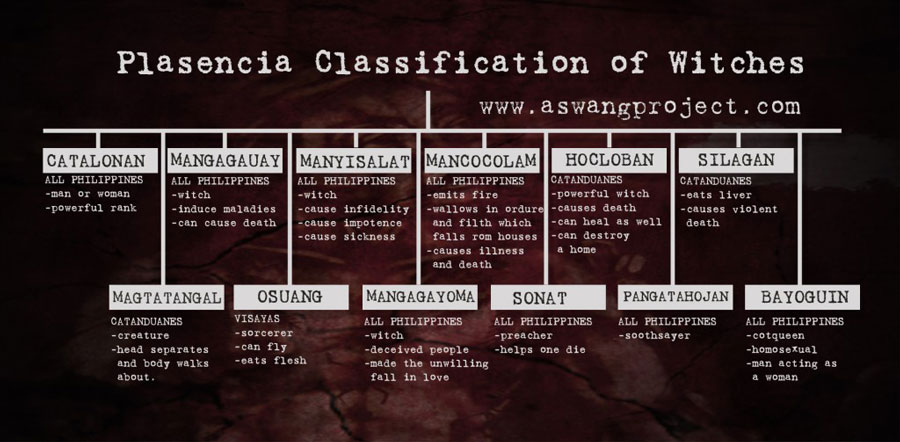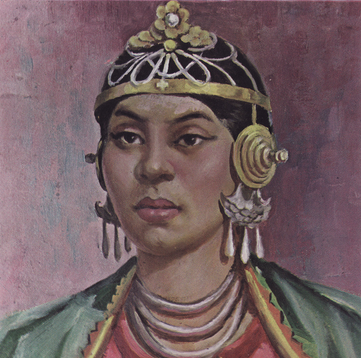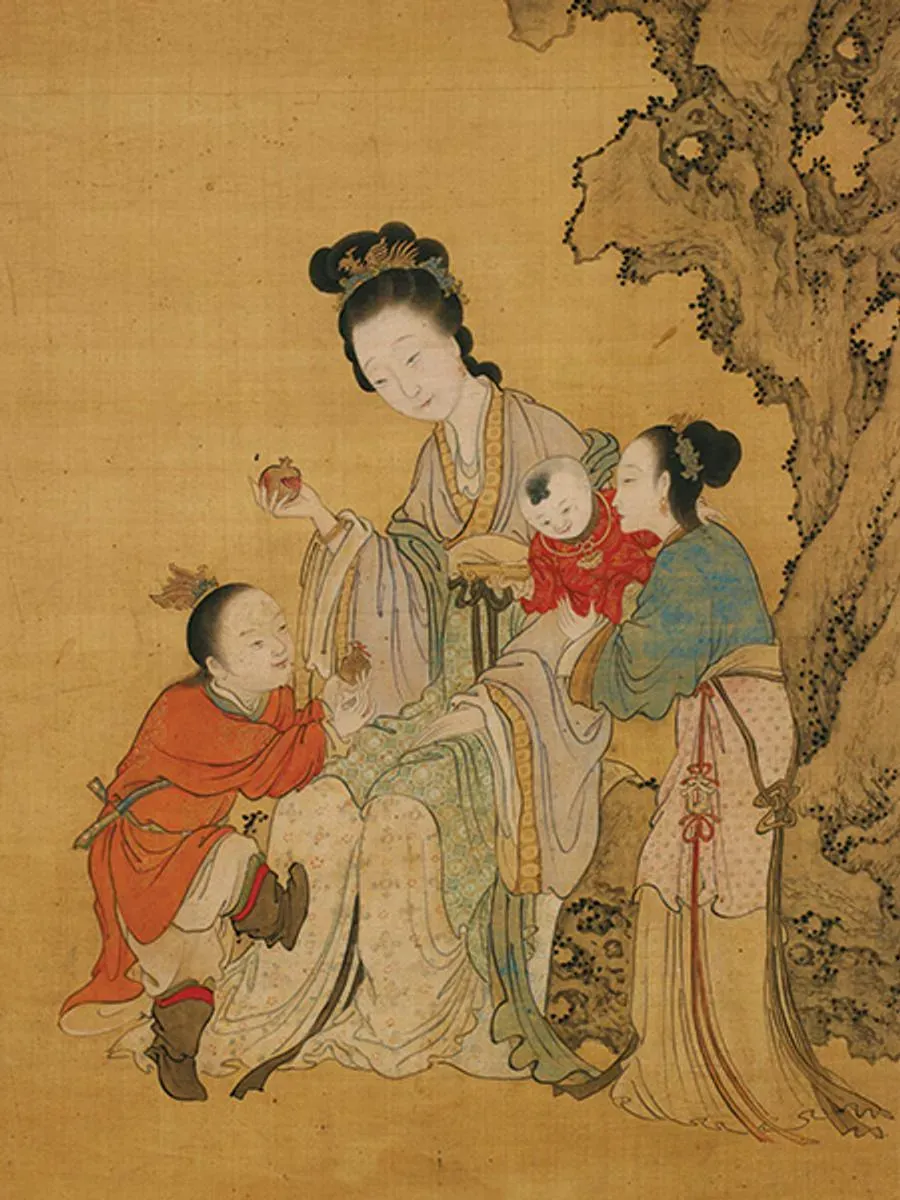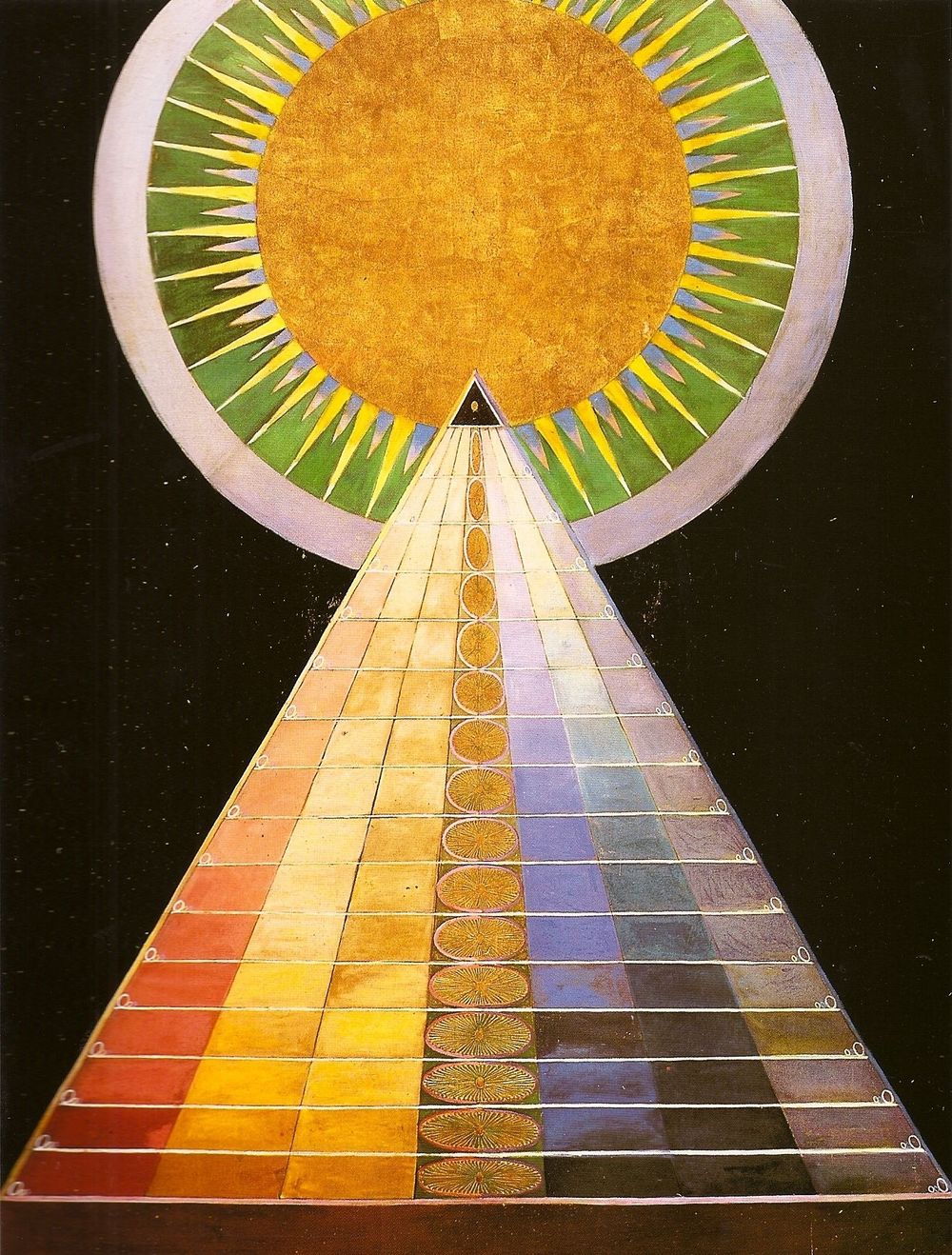We live in a global era characterized by PTSD. Maybe in your own life you’re familiar with how post-traumatic stress disorder works. Traumatic violence distorts memories, and the way we experience time, making violence repeat on a loop like a record skipping. Changing how we see and talk about ourselves.
The witch hunts were a trauma against women and against the earth, and against a worldview that saw holiness and spirituality as the birthright of every being. They were also a weapon in the global violence of colonialism. As we work to disrupt androcentrism – the mind frame that sees masculinity as normal and all else as Other – with feminist history... and to heal from the violence of colonialism… and to resist the worst of earth-eating capitalism however the fuck we can... it’s useful to go looking for places outside of Europe and the americas where women were and are called witches.
One of the many places this happened is in the Philippines and investigating this branch of witch history draws us back, back before the colonial trauma, to honour the women folk therapists, priestesses, warriors, healers, storytellers called Babaylan, and forward, to honour the badass feminists who carry the Babaylan spirit today.
Works Cited
Babaylan: Filipinos and the Call of the Indigenous Editor: Leny Mendoza Strobel 2010 Ateneo de Davao University Research and Publications Office.
The Woman in the Shaman’s Body: Reclaiming the Feminine in Religion and Medicine by Barbara Tedlock Ph.D. 2005 Bantam Books.
Centennial Crossing: Readings on Babaylan Feminism in the Philippines 2006
by FE B. Mangahas (Editor), JennyR. Llaguno (Editor)
https://en.wikipedia.org/wiki/Ibn_Battuta
https://newsinfo.inquirer.net/877464/urduja-a-princess-story-with-a-twist
https://www.tiki-toki.com/timeline/entry/228633/Colonization-of-The-Philippines/
https://en.m.wikipedia.org/wiki/Kulam
http://nightskylie.blogspot.com/2015/06/babaylan-feminism.html
https://www.rappler.com/life-and-style/23735-alma-quinto-artist-cultural-healer
http://muslimheritage.com/article/ibn-battuta
http://perladaly.info/about-me
http://www.angelesarrien.com/index-php/four-fold-way/
https://www.hrc.org/resources/violence-against-the-transgender-community-in-2018
http://babaylanfiles.blogspot.com/2009/04/defining-kapwa.html


Transcript
We live in a global era characterized by PTSD. Maybe in your own life you’re familiar with how post-traumatic stress disorder works. Traumatic violence distorts memories, and the way we experience time, making violence repeat on a loop like a record skipping. Changing how we see and talk about ourselves.
The witch hunts were a trauma against women and against the earth, and against a worldview that saw holiness and spirituality as the birthright of every being. They were also a weapon in the global violence of colonialism. As we work to disrupt androcentrism - the mind frame that sees masculinity as normal and all else as Other - with feminist history - and to heal from the violence of colonialism... and to resist the worst of earth-eating capitalism however the fuck we can - it’s useful to go looking for places outside of Europe and the Americas where women were and are called witches.
One of the many places this happened is in the Philippines and investigating this branch of witch history draws us back, back before the colonial trauma, to honour the women folk therapists, priestesses, warriors, healers, storytellers called Babaylan, and forward, to honour the badass feminists who carry the Babaylan spirit today.
In this episode, we’ll tell the story of Urduja, a pre-colonial warrior heroine who is one aspect of the Babaylan personified. We’ll dip our minds with reverence into the spirit and magic of this sacred spring of world knowledge. And we’ll just try as usual to learn a little something, and not fuck it up.
Ceres Pioquinto, writing her grandmother Lola’s healing spirituality into a context of Babaylan history, gives us a clue to reading this tradition as witch history.
She talks about discovering Barbara Tedlock’s book Woman in the Shaman’s Body:
“All too often women who enter medicine or the ministry still believe they’re stepping into a strictly men’s field, in fact, these are historically women’s fields that menhave since entered. Women have been characterized as mere artisans or craftspeople - weavers and potters - instead of recognized for the creative, life-giving, cosmos-shaping powers these arts represent. Why? The reasons undoubtedly range from misreading of research to sexism pure and simple. But it’s time to take another look at the evidence of millenia and of cultures around the globe. It’s time to reclaim the woman in the shaman’s body (Tedlock 4-5)
In this book, Tedlock takes a fascinating expedition into this ancient tradition from its prehistoric beginnings to the work of women shamans across the globe today. Illuminating the long-hidden female roots of the world’s oldest form of religion and medicine, she argues that humankind’s first spiritual and healing practice was originally the domain of women. In this compelling narrative, Tedlock reveals the hidden and often ignored and/or dismissed female roots of religious and healing practices with a dazzling array of evidence - from prehistoric African rock art to modern Mongolian ceremonies - for women’s shamanic powers. Among others, this book has made me acutely aware of the demonization of wise women by an androcentric culture that first labeled them as witches and burned them alive, and later vilified their gift by calling them quack. As Barbara Tedlock tells me that the first shaman was a woman, my heart leaps at the thought that my Lola’s story adds another evidence of the primacy of women’s role in this life-giving, cosmos-shaping tradition.”
THEME SONG
I should say, this essay and others we’ll get to get into come from Leny Mendoza Strobel’s revelatory collection, Babaylan: Filipinos and the Call of the Indigenous. I love this beautiful book so much, and Leny Strobel’s writing on her own journey that started with an academic interest and unfolded into a revelatory homecoming of personal Babaylan knowingness is a generous and loving spirit guide for anyone seeking a path from their daily work in North America back to their ancestors. You can start with her YouTube talks and website as entry points for understanding Babaylan spirituality, but then if you have the means we always want to triumph spending the money to buy the books from the women whom we lovingly call witches who have taken the time to teach us.
Sidenote - I’m always struggling to not make these history episodes too wonky sounding, I’m not going to drop the full reference every time, but as usual we’ll link to all our sources in the show notes on our website MissingWitches.com
Of Princess Urduja, Tera Maxwell writes that the first written record of her appears in Berber Muslim explorer, botanist and judge Ibn Batuta’s account of his world travels from 1325 to 1354.
“Batuta’s account is called A Gift to Those Who Contemplate the Wonders of Cities and the Marvels of Travelling, and offers insights from the perspective of an Islamic legal scholar in early days of Islamic conversions and collisions with Buddhism, Hinduism and Early Christianity, and on the lives of people in over 40 countries in the Medieval period, from China to the Volga River Valley, from Alexandria to Mahgreb to Tanzania.”
Ibn Battuta describes sailing to Kaylukari in the land of Tawalisi, where he met Urduja, a local princess. Urduja was a brave warrior, and her people are opponents of the Yuan dynasty - the unified Mongolian dynasty under Kublai Khan.
She is described as an "idolater", but could write the phrase Bismillah in Islamic calligraphy.
The Bismillāh is the Islamic phrase bi-smi llāhi r-raḥmāni r-raḥīمِ "In the name of God, the Most Gracious, the Most Merciful". (wikipedia.)
The phrase is considered magical in folk Islam traditions, so maybe we can imagine Urduja picking it up and adding it to her arsenal as a babaylan warrior priestess of a pre-colonial religion. Mazwell writes:
“En route to China, Batuta encounters the lovely princess while visiting the island of Tawalisi, an egalitarian kingdom where the “women ride horses, understood archery, and fight just like the men” (Ibn and Mackintosh-Smith 2002).. Impressed by Urduja’s courtly grace and intelligence, Batuta notes that she speaks Arabic and Turlish, reads from the Qur’an, leads and army of men and women soldiers, and controls the South China Sea with her pirate ships. She is skilled in archery and hand-to-hand combat. In one fierce battle Urduja breaks through enemy lines, kills the enemy king, and brings back his head on a spear.”
Let’s keep this queen in mind, head held high, heads on spears, taking magic phrases from the tongues of those who would convert her, defending her egalitarian, island people. Let’s hold her in our mind eye blazing and pull back to put her in the broader context of the Babaylan. Because the Babaylan is warrior witch, and more. More from Leny Mendoza Strobel:
“What is a Filipina Babaylan? The Babaylan in Filipino indigenous tradition is a person who is giften to heal the spirit and the body; the one who serves the community through her role as a folk therapist, wisdom-keeperand philosopher; the one who provides stability to the community’s social structure; the one who can access the spirit realms and other states of consciousness and traffic easily in and out of these worlds; the one who has vast knowledge of healing therapies.” (Magos 1993)
…
Babaylan: indigenous, shaman, healer, priestess, ritualist, herb doctor, village therapist, diviner, mediator between ordinary and non-ordinary realms of reality. S/he is known by other names in various tribes: Ma-aram, balian, balyan, mumbaki, dawac, catalonan, manogbulong, tambalan, and more. In many tribal communities’ governance structure that included the tribal chief or datu, the bayani/bagani (warrior), and the panday (crafts person), no deicisions were ever made without consulting the Babaylan. These four pillars of a tribe held together the communal life of its members but the Babaylan seemed the most important and powerful and hence became the target of extermination as soon as colonizers arrived in the islands in the 15th century.
Today there are still primary Babaylans in indigenous communities in the Philippines. Outside of these land-based communities the Babaylan is now often disguised and donning a different dress and language; she walks among us like a shadow, revealing herself only to those whose souls cry for her.”
“The majority of Babaylan are women, and when men take on the same role and functions (as they started doing during the Hispanic colonial period) they usually don women’s garments. One can surmise that this shift in outer wear might be symbolic of the privileged role of the Babaylan as a woman’s domain. However, it can also be argued that this privileging of the female gender in this instance can be contested by citing a Filipino creation story where the Creator splits a bamboo and creates simultaneously male and female. In this sense, according to Katrin de Guia, the man-Babaylan honors the mother goddess (Earth) when he approaches her and doing this develops his feminine side in order to balance his masculinity. LIkewise, the woman-Babaylan would develop her masculine side to stabilize her tenderness and all-consuming compassion toward all life forms. That’s why these women lived alone on the fringe of the villages, the heads of enemies on bamboo stakes, while the men, in ceremonials malongs, wore fragrant flowers in their hair. This derives from the bilateral egalitarian kinship system that is at the root of our indigenous cultures.
When the Spanish colonized the Philippines (1521 - 1898), the Babaylan was considered a threat to the colonial and Chritianization project.
…
The animist worldview asserts that all of creation is sacred. It is the role and function of the Babaylan to mediate between the world of the spirits and the human and non-human world and re-member for us the deep connectedness between worlds; thus suturing and healing the split in our psyche.”
And so maybe it is the role of Witch in every culture, especially in the post-traumatic culture, to suture and heal the splits in our psyches. To wake and lead us out of the repetition of trauma to the great exhilarating calm of connection to everything.
Pre-colonial Philippines was neither a patriarchy nor a matriarchy. The division of labor between men and women was a harmony. In a country that lived balanced between destructive waves of fire and water - volcanic eruptions and typhoon - men and women shared in danger equally to nurture and protect their children.
When the Spaniards in the 1500s co-opted the datus - the leaders of the indigenous people who declared their loyalty to the Spanish - the babaylans resisted fiercely. Then, they resisted creatively, adopting Christianity to survive; becoming pasyon chanters. They functioned as a priesthood -- Christians who balanced between the material and nonmaterial world, explains Dr Fe Mangahas in Centennial Crossings, Readings on Babaylan Feminism in the Philippines.
"When the babaylans became rivals of the Spanish priests, the latter called them bruha or witches who allegedly dabbled in black magic. They were demonized and systematically exterminated during the first 100 years of Spanish colonization of the Philippines, and not just murdered but cut in pieces and fed to crocodiles, so heavy was the oppressors terror of these women - and of the transgressive men who lovingly put on women’s clothes and worshipped the divine feminine.”
And if that sounds familiar as a pattern of dominance and terror it should. 2017 was the worst year ever for violence against transgender people in the United States until 2018 came around. The cycle echoes and we have to keep reaching through walls and worlds and across cultures and times to decolonize ourselves and heal. SO let’s be clear, Missing Witches believe if you are transgender you are a brave being of magic, and it is every Witch’s and human’s responsibility to protect you.
We also believe that Witch hunts have been and are a weapon of capitalism. Check out a super fucking badass article called Witches And Class Struggle in Jacobin Magazine where SILVIA FEDERICI writes:
“Feminists were quick to recognize that hundreds of thousands of women could not have been massacred and subjected to the cruelest tortures unless they posed a challenge to the power structure. They also realized that such a war against women, carried out over a period of at least two centuries, was a turning point in the history of women in Europe, the “original sin” in the process of social degradation that women suffered with the advent of capitalism.
…
What has not been recognized is that the witch hunt was one of the most important events in the development of capitalist society and the formation of the modern proletariat. For the unleashing of a campaign of terror against women, unmatched by any other persecution, weakened the resistance of the European peasantry to the assault launched against it by the gentry and the state, at a time when the peasant community was already disintegrating under the combined impact of land privatization, increased taxation, and the extension of state control over every aspect of social life.
The witch hunt deepened the divisions between women and men, teaching men to fear the power of women, and destroyed a universe of practices, beliefs, and social subjects whose existence was incompatible with the capitalist work discipline.”
So to be a witch then, to find the women and men who have been called witch and to honour them, is not just a spiritual act, not just a healing act. It is an act of resistance. And of decolonization.
Artist Alma Urduja Quinto is a modern day Babaylan artist activist who creates art inspired by her work with children survivors of rape and incest, women migrant workers, women laborers, differently-abled and street children, Moro women, peace journalists, orphans, prostitutes, Bicol evacuees, and other participants of her art workshops in various museums, academic institutions and communities all over the Philippines.
“Quinto first learned about Urduja from her mother and grandmother, but in college she ‘embraced her and all her attributes’ She writes, ‘I see myself as a contemporary Babaylan just like all other women who recognize their power to transform and exercise this power to create a peaceful and nurturing environment’. Her appropriation of the name “Urduja” reveals a kind of born-again commitment to Urduja’s legacy. As Quinto recalls, she adopted Urduja’s name to “disseminate information” about the pre-colonial ruler.”
Perla Daly is a designer, art director, and cyber activist, who might fit the description we sketched of a techno shaman or digital witch from last season’s Brenda Laurel offering.
As a visual communicator and art director she earns a living designing for companies like Apple, Google and IBM, but she also contributes design and writing to the contemporary flowering of the Babaylan.
Daly is the artist behind the Babaylan Mandalas - a polyglot of symbols, echoes, and references to indigenous spirituality. She also developed meditation guides based on Angeles Arrien’s archetypes in the Four Fold Way that focus on the Babaylan’s spirit and leadership, specifically for Filipina women willing to learn from the Babaylan path. Of these she writes:
“Perla Daly summarizes these roles briefly based on her personal encounters with Babaylans.
Healer/Water
My first understanding of the Babaylan was from personal experience. I realized that the hilot is a Babaylan. He or she is the village healer or hilot (bone setter, massage therapy) and herbolario (herbalist). Our family had one of two favorites in the barrio.
A healer removes dis-ease and disease and brings about health and wholeness in the physical and emotional well-being of the community.”
…
Seer / Visionary / Air
My second understanding of the Babaylan from personal experience was the seer or psychic truth-teller. Most of these hilots I encountered also had the gift of third-sight. They peered at you as if looking through to your very soul, and they knew things about you, your past, your future, through the bumps and depressions of your skull, the shape of your bones, by reading cards or just by looking at you.
A visionary intuits and perceives truth and understanding and shares this with family and/or community, from which action is taken to move forward toward harmony and peace.
Teacher/Earth
The teacher harvests knowledge and heritage, processes, nurtures and develops knowledge and heritage and plants seeds for future generations to harvest. I met two women who embodied the teacher archetype outright. The first was Leny who was an associate professor who taught and was writing, publishing and bringing about active community dialogue on the topic of decolonization. This discussion of decolonization was also a process of individual and community healing - so here was a very good example of a teacher archetype doing work with essential healing- thus dual essences of teacher and healer within her work.
The other teacher was a young woman named Bing. She worked in the Ilocos mountains. Having learned the oral histories in song, she was taught by tribal storytellers throughout those hills. She traveled from village to village to learn and impart legends and poetry in song and music. She was an initiated and honoured Babaylan, one of the youngest who was eager to receive the seeds of heritage from our elders and spread and plant them within the communities.
Warrior / Fire
I was exploring the deeper meaning of feminism for a few years by this time and had already come to the realization that the feminist was embodied by a few archetypes, too. One of these is the Warrior archetype - the fiery, angry woman who demands justice and equality. So my third understanding of the Babaylan as a leader was the warrior. In the Philippine culture we have these babaylan warriors named as the historical Gabriela Silang and the legendary Princess Urduja.
I realized that feminism and Babaylan were related somehow, and I was determined to figure out how. As I began to find my own voice and express it in online communities such as newfilipina.com and in online discussion groups, and as I witness other brave women and men find their voices to speak up on behalf of the exploited or the oppressed, I realized that the Babaylan spirit of the warrior is in us when we speak up and openly for justice and risk the consequences of the powers-that-be and society at large.
Priestess ? Light
My understanding of Babaylan as a ritualist or priestess was given to me when I read both of the books of Mary Lou Hardillo-Werninga and Eileen Tabios. They both defined Babaylan as women community healers, leaders, and priestesses.
The word priestess resonated with me and made me excited. It was a new discovery of roles that were actually possible for women in the past in my own people’s history. And possibly in the present, because it just so happened that I had become acquainted with my first Filipina priestess, Letecia, while in my first days of publishing Bagong Pinay. Letecia was ordained in three Goddess traditions, including the Temple of Isis and the Dianic Tradition. During her first formal training by elders, that included rituals and women;s mysteries, she reached into her ancestral roots, finding what she could in the ethnographic writings (thanks to LInda Nietes) and using the Mandaya tribal practices of the Baylan as guide.”
Daly lives and gives life to a kind of diversity of practice that is hyper-contemporary in our interconnected times, and also true to pre-Spanish Philippines.
“Katrin de Guia describes the Babaylan as she who still knows sacred time and space and who remembers this with every cell of her body before she was interpellated by history. The Filipina, as a culture-bearer, has colonial history written in her body. Because of this colonial miseducation that centers Spanish and American influences, De Guia writes that what is hardly mentioned in Babaylan literature are the Buddhist and Muslim influences on the Filipino culture. These influences are hardly mentioned in English and Spanish texts. Yet if we consider that the Babaylan epitomizes the global animist, the Asian Bug=ddhust, the Oriental Muslim, traditional European, modern American, and postmodern global culture - doesn’t this make the shamanic tradition of the Babaylan so unbelievably rich? It’s not even the layers that are important but the retention of ancestral memory, despite all the layers, integrating matching elements due to the inherent “including” strength of the Kapwa culture. The Babaylan is recognized by her community as this embodiment of the power of Kapwa. This is what sets her apart. All would-be Babaylans are culture-bearers but not all culture-bearers are necessarily Babaylan.”
What is Kapwa? It is at the heart of a babaylan philosophy, and I think it’s the key to understanding witchcraft as a revolutionary political philosophy as well:
According to Leny Mendoza Strobel:
“One of the most difficult questions and tasks about dismantling privilege is this requirement to shift our understanding of the Self from the "I" to "We/kapwa."
In the latter, we (privileged Americans) must begin to know and feel deeply that our affluent lifestyles have a social cost and a social burden that is carried by the poor of the world and the Earth...
One of the most important features of the Indigenous Knowledge Systems and Practices (IKSP) is the tendency to see the world with all its beings as a holistic system where things operate interdependently. Harmony with other people and the environment is a much-needed trait today in our shrinking global village. This orientation is called "kapwa"—the shared self.”
Perla Daly created her Babaylan Mandala to be a gift of healing for a people
- whose identity and dignity were fragmented historically
- who lost their connection to their ancestors, their noble beliefs, and their ancestral pride
- who lost the awareness of their inner gold in a striking parallel to the loss of the immense wealth of gold that was once abundant in the islands before the conquistadores brought it back to Spain
She offers this rallying cry, and I hope it will give you light and strength for the battle we fight together to decolonize our minds and our lands. If it helps, close your eyes and remember Urduja. Beloved leader of warriors, women and men. She who would take the language of those who would convert her to forge her own magic. Taking the heads of her would be violators and taking no shit. Giving all those who would defend the earth and our profound interconnectedness the fire of her vivid magic.
The Babaylan Mandala represents YOU,
your soul and existence in the cosmos.
YOU are the BAHALA Tree of Life at the center of Creation.
With symbols and sacred numbers
The Mandala tells you
you are kapwa, kin, connected
to Everything
Earth, Water, Air and Fire,
Seen and Unseen,
Dark and Light,
Macrocosm and Microcosm.
You are not alone…
You are kin — kapwa —
to all blessed beings and Creation.
Beautiful, beloved,
blessed friend,
Behold!
See now
how expansive
and un-alone
you truly are!
you are kapwa, kin, connected
to Everything.





